This website uses cookies so that we can provide you with the best user experience possible. Cookie information is stored in your browser and performs functions such as recognising you when you return to our website and helping our team to understand which sections of the website you find most interesting and useful.
HATCH COVER MAINTENANCE
Download PDFPublished: 1 December 2013
Updated: 6 December 2023
The lack of hatch cover maintenance and/or improper repairs to hatch covers has been shown to be the primary cause of water ingress into the cargo holds which can lead to cargo damage. In addition to the financial and insurance claims, there are other potentially more serious consequences that need to be considered:
- Fire – is the cargo being carried likely to self heat or combust when wet?
- Accelerated corrosion – is the cargo being carried reactive to moisture (e.g. sulphur)?
- Loss of stability – is the cargo being carried prone to liquefaction when wet?
Any one of the above could potentially lead to the loss of the vessel and possible loss of life.
Through the Club’s condition programme and data taken from claims histories, certain trends have been noted with regard to hatch cover maintenance or rather the lack of maintenance and also the lack of awareness of ship staff to the maintenance requirements. Unfortunately, there seems to be an ever- increasing number of claims due to water ingress and the costs of such claims are increasing. The aim of this guidance is to highlight the most common defects and to emphasise the importance of proper maintenance routines. In addition, it will discuss the safety considerations to be taken into account when working on or operating ships hatch covers.
THE BASIC PROCEDURES
Hatch cover maintenance routines should be drawn up following the manufacturer’s recommendations as well as taking into consideration Classification Society requirements and the ship’s trading patterns. Ship staff should be familiar with these requirements and checklists should be developed to cover all the items to be checked/inspected at each stage and these records need to be maintained.
Before the ship leaves port, all the weather deck hatch covers should be closed properly and all locking devices secured. Regular checks should be carried out on the security of the hatch covers whilst at sea and this is even more important when heavy weather is expected, as it may not be possible once the weather has deteriorated.
Only qualified personnel should operate the hatch covers. They should be well-trained and be fully aware of the manufacturer’s procedures for the safe operation of the hatch covers that have been fitted to their particular ship. A proper risk assessment needs to be carried out and this needs to be reviewed regularly and ship staff briefed and trained as to its contents.
Once opened, hatch covers should be secured properly, using the chain stoppers, chocks or other devices recommended by the manufacturers. Hatch openings should be well-illuminated and if there are guard rails and stanchions fitted, these need to be fixed into place.
Special care and attention should be paid to opening and closing of the hatch covers when the ship has an excessive trim or list. This is due to the possibility of the covers “running away” when in motion.
It is not recommended to open the hatch covers whilst at sea to carry out maintenance and repairs but there will be times when it is necessary. In such cases, it must be carefully considered, taking into account crew safety and the anticipated weather and sea conditions. It may be necessary to take additional measures to secure the hatch covers in the open position to prevent them moving when the ship is moving.
GENERAL MAINTENANCE AND ROUTINES
Continuous monitoring of the condition of the hatch covers and their sealing arrangements is best done when the covers are being opened and closed during operations. This continuous monitoring serves as an early warning and hopefully will prevent the development of more serious problems.
The following is a list of the common defects found during ship inspections and cargo damage investigations. This list is by no means exhaustive, it is a list of inspection and maintenance items that should form part of the ship’s regular routine.
- Before closing the hatch covers, ensure that the hatch coamings and double drainage channels are swept clean of any cargo debris. This will ensure that the coaming drain non-return valve remains clear and free as well as ensuring that no damage occurs to either the hatch cover rubber packing or the compression bar. It will also ensure that there is no obstruction to the correct and proper sealing of the hatch cover.

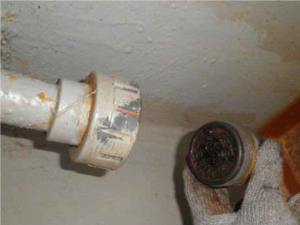
Hatch coaming not swept, cargo debris and
rust still evident. Centreline joint closing
wedge showing severe wearHatch coaming drain completely blocked
with debris and rust - Whilst cleaning, check for any damage to the coaming area, paying particular attention to the compression bars, wheels, wheel tracks and landing pads. Record details of any damages found for urgent or future remedial repairs as required. If temporary repairs are required, it must be ensured that these temporary measures are such that the ship’s cargo worthiness will not be affected for the entirety of the voyage. Ensure that the moving parts (wheels, cross joint hinges, hydraulic ram bearings etc.) are greased at regular intervals.

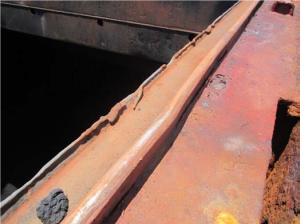
Hatch cover guide wheel bearing failed –
hatch cover will not close evenlyMechanical damage to the compression bar
and inner drain channel - If the hatch cover design is such that the cover side panels and end plates are in ‘steel to steel’ contact with the hatch coaming tops when in the closed position, check whether the coaming tops are free from grooving or wear. This would indicate worn hatch sealing rubbers.
- Hatch cover landing pads should be maintained in a good condition at all times, ensuring that any corrosion is dealt with in a timely manner and that the pads are greased regularly.
- Grooved , corroded or worn down landing pads are to be either built up with welding and ground back to original dimensions or cropped off and replaced in their entirety.
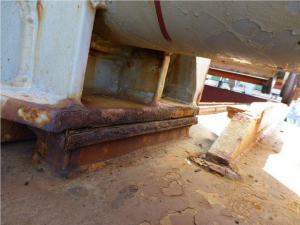
Corroded and wasted hatch cover landing pads - Check for any rust streaks on the inside of the coaming which would indicate water ingress from leaking hatch cover seals. Take remedial action and repair the seal and clean off the rust streaks.

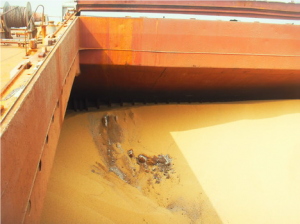
Evidence of water ingress at the cargo hold entrance hatch and the hatch coaming - Check and clean the surface of the seals. This is particularly important if the cargo being carried is gritty or dusty.
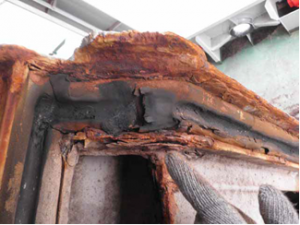
Hatch cover sealing rubbers damaged and showing permanent deformation beyond the recommended limits.
Rubber seal channels severely corroded.
- When cleaning the seals, check for signs of permanent deformation (a useful general rule is 30% of the seal thickness). If sections of sealing rubber are required to be replaced, the minimum length is 1m. However, it is often better to replace a full length of sealing rubber to ensure effective and even compression.
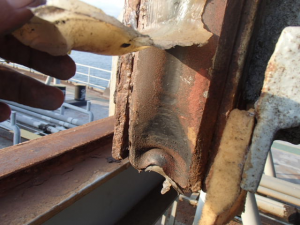
Silicone applied in an attempt to effect proper sealing - Hold access hatches and ventilation covers need to be carefully scrutinised in the same manner as the hatch covers themselves, for signs of damage to the sealing areas, securing arrangements etc.
- The function of the cleats is to keep the hatch covers in position and maintain the seal’s design compression. The excessive tightening of cleats will not improve weather tightness but will lead to the accelerated wear of the seals and the landing pads and could even distort the hatch cover. Cleats and their snugs should be inspected for any damage, ensure the rubber washer is intact and not perished and the tightening nut is free to move.
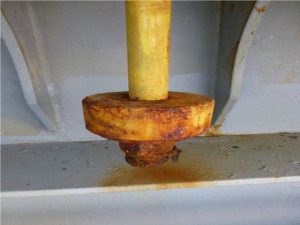
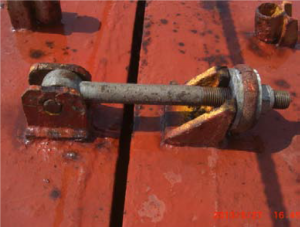
Hatch securing cleat, seized and painted over Cross joint cleat renewed but old perished
rubber still in use - Standard adjustment of the hatch cleats is to tighten the nut hand tight against the steel washer and then to further tighten by 360 degrees.
- Hauling wires/chains need to be inspected for correct adjustment and tension to avoid uneven seating and hatch cover distortion when closed.


Same class of vessel, same age, two different Owners, can you spot the difference?
TESTING
Members may already be familiar with the hose testing method, which the crew can perform regularly, without the need for specialist equipment or training. The hose test must be conducted in accordance with IACS requirements, which requires a powerful jet of water from a 20-50mm diameter hose fitted with a 12mm diameter nozzle held at 1-1.5 metres from a hatch joint, moving along the joint at a speed of 1 meter every 2 seconds. The issue with this testing is that:
• The water jet from the hoses sometimes may not be powerful enough to penetrate defective areas
• The person testing may not cover all the joints
• Does not provide information on the degree of compression of the packing rubber
While these tests cannot guarantee that the hatches are weathertight, they can indicate the likelihood of leaks and enable necessary remedial actions to be taken before the vessel departs. It is recommended that hose tests be carried out in the calm waters of a port.
Ultrasonic testing offers an advantage by bypassing the limitations associated with hose testing. Utilising ultrasonic equipment is a contemporary and effective approach for assessing the weathertight integrity of various components, including hatchcovers, access hatches, doors, and ventilators. This method facilitates swift and precise identification of leak locations. Following the test, a visual inspection to determine the cause of leakage should be conducted, leading to the appropriate remedial action.
Additionally, ultrasonic testing is strongly advised at routine intervals to demonstrate the weathertight integrity of the vessel’s hatches, thus protecting the Member’s position in case of a related claim. The Club strongly recommends conducting third-party verification tests at regular intervals, despite the absence of statutory requirements or industry guidance on the frequency.
A note on the use of sealing tape or foam, if a charterer insists on using them, shipowners are advised to have the hatch covers tested (preferably using ultrasonic testing) and inspected by an independent surveyor to ensure weathertightness before departing the load port. The results of the test and inspection should be carefully documented to demonstrate that the use of Ramnek tape or expansion foam was solely an additional precaution at the charterer’s request.
It is evident from the results of the Club’s claims and survey programme that hatch cover problems affect young and old ships. It is also important to recognise that effective maintenance can be achieved at minimum cost by both ship and shore staff implementing sound procedures and remaining alert to maintenance issues while on board the ship.

 English
English